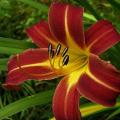Daylily 'White Triangle' {Bare Root Plants, min 25}
This item has been discontinued.
Related Products
 Daylily 'Autumn Red' Bare Root Plants, min 25 $6.47 or less |
 Daylily 'Happy Returns' 1-Gallon pot $28.97 or less |
 Daylily 'Happy Returns' 2-Gallon pot $39.47 or less |
 Daylily 'Happy Returns' tray of 38 cells $238.26 ($6.27 per plant) |
 Daylily 'Hyperion' Bare Root Plants, min 25 $9.97 or less |
 Daylily 'Kwanso' Bare Root Plants, min 25 $5.77 or less |
 Daylily 'Nashville Star' Bare Root Plants, min 25 $6.47 or less |
 Daylily
'Orange' Bare Root Plants, min 25 On sale: $2.97 Discount: 50% On Sale! |
 Daylily 'Purple de Oro' Bare Root Plants, min 25 $5.47 or less |
 Daylily 'Ruby Stella' Bare Root Plants, min 25 $6.47 or less |
 Daylily 'Sammy Russell' Bare Root Plants, min 25 $6.47 or less |
 Daylily 'Stella de Oro' 1-Gallon pot $28.97 or less |
 Daylily 'Stella de Oro' 2-Gallon pot $39.47 or less |
 Daylily 'Stella de Oro' Bare Root Plants, min 25 $5.97 or less |
 Daylily 'Stella de Oro' 3 1/2 in. Pots min 25 $6.87 or less |
 Daylily 'Stella de Oro' tray of 38 cells $202.92 ($5.34 per plant) |
 (0)
(0)